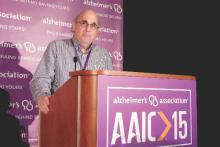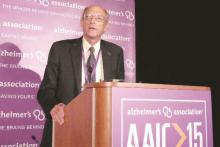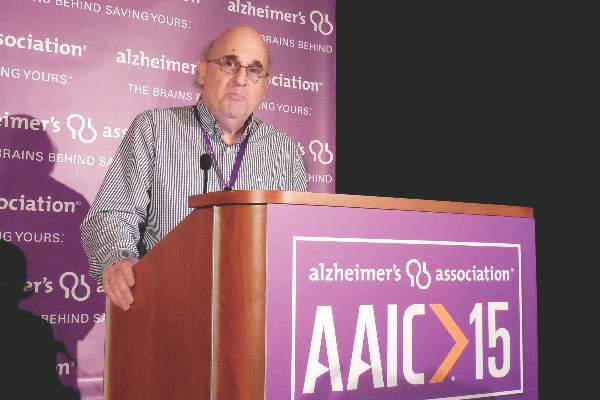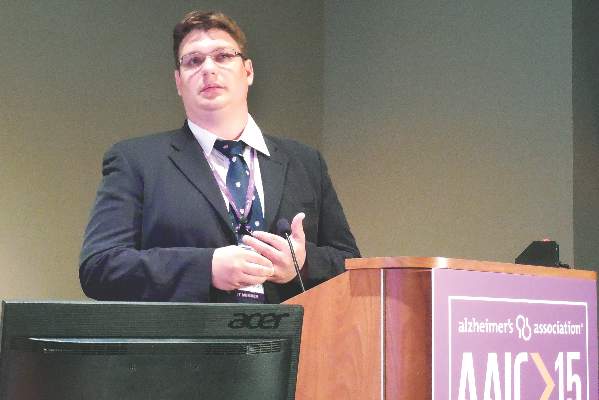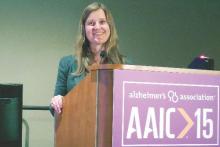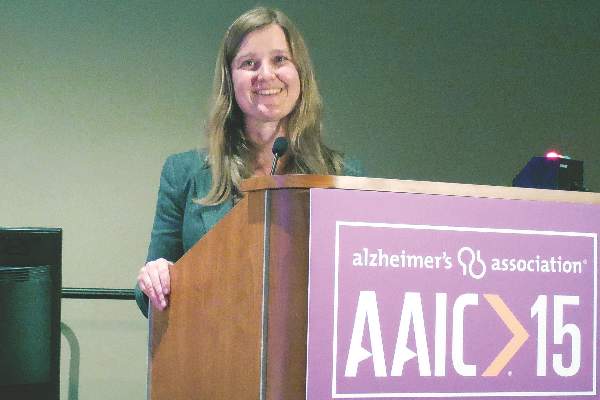User login
Alzheimer's Association International Conference 2015 (AAIC)
EEG detects early conversion to Alzheimer’s disease
WASHINGTON – Electroencephalography combined with novel software can distinguish mild cognitive impairment (MCI) from prodromal Alzheimer’s disease years before clinical symptoms become evident, according to a longitudinal assessment of patient data from a memory clinic in Iceland.
Monitoring electrophysiology could be used to select subjects for clinical trials who have yet to, but likely will, develop Alzheimer’s, said the investigators, led by Kristinn Johnsen, Ph.D., chief scientific officer at MentisCura, an Icelandic company developing the technology.
The software applied statistical pattern recognition to a large set of electroencephalography (EEG) features gathered from 169 individuals with MCI from the Memory Clinic at National University Hospital, Reykjavik, Iceland, over the course of 10 years’ follow-up to predict conversion from MCI to Alzheimer’s within 3-4 years, with a sensitivity of 87% and specificity of 79%.
During follow-up, 68 were diagnosed with AD after varying times ranging from 1 to nearly 10 years. Another 56 subjects had MCI that remained stable for at least 3 years, the researchers noted in a poster presented at the Alzheimer’s Association International Conference 2015.
A total of 24 subjects developed other dementias, and 21 were lost to follow-up. The groups were similar at baseline in gender, age in the mid-70s, and Mini-Mental State Examination score.
A Kaplan-Meier plot of the patients who were pegged as being likely to convert based on the stratification index revealed a curve similar to that of patients who had Alzheimer’s at baseline, with divergence of the curves occurring only after 3-4 years. In contrast, a Kaplan-Meier plot of the conversion of the full MCI cohort to Alzheimer’s separated from the curve of patients who had Alzheimer’s at baseline almost immediately.
The EEG software is already in routine clinical use in Iceland, with more than 700 patients with suspicion of dementia having been examined, according to Thora Thorgilsdottir of MentisCura. The technology has not yet been approved by the Food and Drug Administration and is available in the United States only for investigational purposes.
WASHINGTON – Electroencephalography combined with novel software can distinguish mild cognitive impairment (MCI) from prodromal Alzheimer’s disease years before clinical symptoms become evident, according to a longitudinal assessment of patient data from a memory clinic in Iceland.
Monitoring electrophysiology could be used to select subjects for clinical trials who have yet to, but likely will, develop Alzheimer’s, said the investigators, led by Kristinn Johnsen, Ph.D., chief scientific officer at MentisCura, an Icelandic company developing the technology.
The software applied statistical pattern recognition to a large set of electroencephalography (EEG) features gathered from 169 individuals with MCI from the Memory Clinic at National University Hospital, Reykjavik, Iceland, over the course of 10 years’ follow-up to predict conversion from MCI to Alzheimer’s within 3-4 years, with a sensitivity of 87% and specificity of 79%.
During follow-up, 68 were diagnosed with AD after varying times ranging from 1 to nearly 10 years. Another 56 subjects had MCI that remained stable for at least 3 years, the researchers noted in a poster presented at the Alzheimer’s Association International Conference 2015.
A total of 24 subjects developed other dementias, and 21 were lost to follow-up. The groups were similar at baseline in gender, age in the mid-70s, and Mini-Mental State Examination score.
A Kaplan-Meier plot of the patients who were pegged as being likely to convert based on the stratification index revealed a curve similar to that of patients who had Alzheimer’s at baseline, with divergence of the curves occurring only after 3-4 years. In contrast, a Kaplan-Meier plot of the conversion of the full MCI cohort to Alzheimer’s separated from the curve of patients who had Alzheimer’s at baseline almost immediately.
The EEG software is already in routine clinical use in Iceland, with more than 700 patients with suspicion of dementia having been examined, according to Thora Thorgilsdottir of MentisCura. The technology has not yet been approved by the Food and Drug Administration and is available in the United States only for investigational purposes.
WASHINGTON – Electroencephalography combined with novel software can distinguish mild cognitive impairment (MCI) from prodromal Alzheimer’s disease years before clinical symptoms become evident, according to a longitudinal assessment of patient data from a memory clinic in Iceland.
Monitoring electrophysiology could be used to select subjects for clinical trials who have yet to, but likely will, develop Alzheimer’s, said the investigators, led by Kristinn Johnsen, Ph.D., chief scientific officer at MentisCura, an Icelandic company developing the technology.
The software applied statistical pattern recognition to a large set of electroencephalography (EEG) features gathered from 169 individuals with MCI from the Memory Clinic at National University Hospital, Reykjavik, Iceland, over the course of 10 years’ follow-up to predict conversion from MCI to Alzheimer’s within 3-4 years, with a sensitivity of 87% and specificity of 79%.
During follow-up, 68 were diagnosed with AD after varying times ranging from 1 to nearly 10 years. Another 56 subjects had MCI that remained stable for at least 3 years, the researchers noted in a poster presented at the Alzheimer’s Association International Conference 2015.
A total of 24 subjects developed other dementias, and 21 were lost to follow-up. The groups were similar at baseline in gender, age in the mid-70s, and Mini-Mental State Examination score.
A Kaplan-Meier plot of the patients who were pegged as being likely to convert based on the stratification index revealed a curve similar to that of patients who had Alzheimer’s at baseline, with divergence of the curves occurring only after 3-4 years. In contrast, a Kaplan-Meier plot of the conversion of the full MCI cohort to Alzheimer’s separated from the curve of patients who had Alzheimer’s at baseline almost immediately.
The EEG software is already in routine clinical use in Iceland, with more than 700 patients with suspicion of dementia having been examined, according to Thora Thorgilsdottir of MentisCura. The technology has not yet been approved by the Food and Drug Administration and is available in the United States only for investigational purposes.
AT AAIC 2015
Key clinical point: Early conversion from mild cognitive inhibition to clinical Alzheimer’s disease can be detected via electroencephalography.
Major finding: EEG of individuals with MCI predicted conversion to Alzheimer’s within 3-4 years, with a sensitivity of 87% and specificity of 79%.
Data source: Single-institute, prospective, follow-up study of 169 patients.
Disclosures: Dr. Johnsen is chief scientific officer at MentisCura, which sponsored the study.
AAIC: Proving drugs modify Alzheimer’s disease faces skepticism
WASHINGTON – Proving disease modification of Alzheimer’s disease in a clinical drug trial may not be easy.
Some researchers developing drugs for treating Alzheimer’s disease hope to find a way to tweak the classic, double-blind, phase III trial design to gather data that can prove a drug has disease-modifying effects in addition to the standard goal of showing symptomatic treatment effects. But the complex statistical analyses they have developed to accomplish this faced some skepticism from Food and Drug Administration staff members during a panel discussion at a special session on the topic at the Alzheimer’s Association International Conference 2015.
“Everyone agrees that No. 1, we need to have drugs that are proven effective, but both clinicians and families want to know whether it’s important to start treatment of Alzheimer’s disease as early as possible or wait, and they want to know whether the benefits of treatment will persist or increase with time,” explained Dr. Paul Aisen, professor of neurology and director of the Alzheimer’s Therapeutic Research Institute at the University of Southern California, Los Angeles. Both properties – added value to patients from early initiation of treatment and persistent or accruing benefit from prolonged treatment – are hallmarks of a disease-modifying effect. “This is what we are trying to get at” with novel trial designs and analysis, he said in an interview. “It’s secondary to talking about efficacy, but it’s still clinically important.”
“Disease modification is an important concept because it indicates that the drug is affecting the underlying biology of the disease. What we have now [for treating Alzheimer’s disease] are drugs that only affect symptoms or are palliative,” commented Dr. David S. Knopman, professor of neurology at the Mayo Clinic in Rochester, Minn. and a participant in the session on disease modification at the meeting. “In principal a drug with a disease-modifying effect would have a bigger and more enduring effect and could be started earlier in the disease and would ultimately be of greater benefit to patients and society by reducing disease burden. The problem is that showing disease modification turns out to be very challenging,” Dr. Knopman said in an interview.
Solanezumab tested in delayed-start studies
During the session at the meeting, Dr. Aisen, the session organizer, presented results from post-hoc analysis of data collected in two phase III trials that tested the efficacy of the antiamyloid antibody solanezumab in patients with mild or moderate Alzheimer’s disease. Results from the placebo-controlled, double-blind phases of the two trials, EXPEDITION 1 and EXPEDITION 2, failed to show a statistically significant benefit from solanezumab treatment for the studies’ primary endpoint. Those findings appeared in a paper published last year (N Engl J Med. 2014 Jan 23;370:311-21).
The new analyses that Dr. Aisen reported came from the open-label extension phase of the two trials, which enabled patients originally enrolled in the placebo arms to start treatment on solanezumab, while patients from the active-treatment arms could remain on longer-term treatment with the drug. The new analyses also focused exclusively on patients who entered the study with “mild” Alzheimer’s disease, defined as a score on the Mini Mental State Examination of 20-26.
Post-hoc analysis of the combined trial results indicated that at the end of the 18-month, placebo-controlled phase patients who entered with mild Alzheimer’s disease had a statistically significant benefit from solanezumab treatment, compared with the placebo group. This observation led to the launch of a new trial, EXPEDITION 3, that exclusively enrolled patients with mild Alzheimer’s disease but in other ways resembled the first two failed trials. Results from EXPEDITION 3 are expected sometime in early 2017, Dr. Aisen said.
The analysis of extended treatment, which produced a trial design known as “delayed start,” aimed to test whether solanezumab produced disease modification of Alzheimer’s disease. The concept was that if the initial 18 months of drug treatment of patients in the active arm produced true disease modification then the difference in efficacy between the active and placebo arms in patients with mild disease seen at 18 months should remain roughly constant over subsequent months of solanezumab treatment of all patients, with no catchup by the patients first randomized to placebo and no hence no convergence of the outcome curves of the two treatment subgroups: patients on continuous solanezumab treatment and patients who first received placebo and then had a delayed start on solanezumab.
At the end of the EXPEDITION 1 and EXPEDITION 2 trials, 654 patients from the active-treatment arms remained enrolled and continued solanezumab treatment and 660 patients from the placebo arms remained enrolled and started solanezumab treatment for the first time. All patients continued on active treatment for up to 24 additional months, although many eventually dropped out of treatment and follow-up. After 2 years of extended treatment, 323 patients remained in the group that had initially been in the active treatment arms and 303 patients remained from those initially enrolled in the placebo arms.
Dr. Aisen presented results that compared the early-start and delayed-start subgroups by four different measures of efficacy, and each of the four analyses showed that the separation between the outcomes of the two treatment subgroups remained fairly constant during follow-up of as long as 2 years, findings consistent with the hypothesis of disease modification according to the statistical tests developed by researchers at Lilly, the company that sponsored the EXPEDITION studies and is developing solanezumab. “The curves are consistent across measures and over time. The late-start group did not appear to catch up. The shape of the curves supports disease modification,” Dr. Aisen said.
“This is the first time that a delayed start methodology has been analyzed in an Alzheimer’s disease clinical trial,” he noted.
The FDA’s view
Several staffers from the FDA who formed a panel at the session to discuss the results and the delayed-start trial design as a way to try to prove disease modification expressed skepticism about the validity and relevance of this analysis.
“The delayed-start design is a clever idea, but it is tough to establish disease modification,” said Lisa LaVange, Ph.D., director of biostatistics in the FDA’s Center for Drug Evaluation and Research. “The new methods [for analyzing delayed-start outcomes] are intriguing, but you want to show that the difference doesn’t deteriorate with time, and that requires the first difference [at the end of the placebo-controlled phase] to be significant and meaningful. You need to show first one thing, and then another, and that’s complicated.”
Dr. LaVange also highlighted the issue of many patients dropping out from the extended-treatment phase. “One of the biggest problems with delayed start is the missing-data problem. We need to be very careful when imputing missing data for dropouts. The missing data aspect of delayed start needs more attention.”
Another concern voiced by the FDA staffers who commented on delayed-start trials and trying to prove disease modification was the paramount importance of showing efficacy during the placebo-controlled phase of the trial.
“We want to modify the disease, but the prize is clearly a large treatment effect. Disease modification is absolutely not required for drug approval,” said Dr. William Dunn, director of the division of neurology products for the FDA’s Center for Drug Evaluation and Research. “What we are after is a treatment effect.”
The EXPEDITION trials and the delayed-start analysis for disease modification effects were funded by Lilly, the company developing solanezumab. Dr. Aisen has received research support from Lilly. Dr. Knopman received an honorarium from Lilly for chairing the data and safety-monitoring committee for two of their trials through 2012, but since then he has not had a financial relationship with the company. He currently is an investigator in a trial sponsored by Lilly. Dr. Knopman said he has no other disclosures. Dr. LaVange and Dr. Dunn had no disclosures.
On Twitter @mitchelzoler
WASHINGTON – Proving disease modification of Alzheimer’s disease in a clinical drug trial may not be easy.
Some researchers developing drugs for treating Alzheimer’s disease hope to find a way to tweak the classic, double-blind, phase III trial design to gather data that can prove a drug has disease-modifying effects in addition to the standard goal of showing symptomatic treatment effects. But the complex statistical analyses they have developed to accomplish this faced some skepticism from Food and Drug Administration staff members during a panel discussion at a special session on the topic at the Alzheimer’s Association International Conference 2015.
“Everyone agrees that No. 1, we need to have drugs that are proven effective, but both clinicians and families want to know whether it’s important to start treatment of Alzheimer’s disease as early as possible or wait, and they want to know whether the benefits of treatment will persist or increase with time,” explained Dr. Paul Aisen, professor of neurology and director of the Alzheimer’s Therapeutic Research Institute at the University of Southern California, Los Angeles. Both properties – added value to patients from early initiation of treatment and persistent or accruing benefit from prolonged treatment – are hallmarks of a disease-modifying effect. “This is what we are trying to get at” with novel trial designs and analysis, he said in an interview. “It’s secondary to talking about efficacy, but it’s still clinically important.”
“Disease modification is an important concept because it indicates that the drug is affecting the underlying biology of the disease. What we have now [for treating Alzheimer’s disease] are drugs that only affect symptoms or are palliative,” commented Dr. David S. Knopman, professor of neurology at the Mayo Clinic in Rochester, Minn. and a participant in the session on disease modification at the meeting. “In principal a drug with a disease-modifying effect would have a bigger and more enduring effect and could be started earlier in the disease and would ultimately be of greater benefit to patients and society by reducing disease burden. The problem is that showing disease modification turns out to be very challenging,” Dr. Knopman said in an interview.
Solanezumab tested in delayed-start studies
During the session at the meeting, Dr. Aisen, the session organizer, presented results from post-hoc analysis of data collected in two phase III trials that tested the efficacy of the antiamyloid antibody solanezumab in patients with mild or moderate Alzheimer’s disease. Results from the placebo-controlled, double-blind phases of the two trials, EXPEDITION 1 and EXPEDITION 2, failed to show a statistically significant benefit from solanezumab treatment for the studies’ primary endpoint. Those findings appeared in a paper published last year (N Engl J Med. 2014 Jan 23;370:311-21).
The new analyses that Dr. Aisen reported came from the open-label extension phase of the two trials, which enabled patients originally enrolled in the placebo arms to start treatment on solanezumab, while patients from the active-treatment arms could remain on longer-term treatment with the drug. The new analyses also focused exclusively on patients who entered the study with “mild” Alzheimer’s disease, defined as a score on the Mini Mental State Examination of 20-26.
Post-hoc analysis of the combined trial results indicated that at the end of the 18-month, placebo-controlled phase patients who entered with mild Alzheimer’s disease had a statistically significant benefit from solanezumab treatment, compared with the placebo group. This observation led to the launch of a new trial, EXPEDITION 3, that exclusively enrolled patients with mild Alzheimer’s disease but in other ways resembled the first two failed trials. Results from EXPEDITION 3 are expected sometime in early 2017, Dr. Aisen said.
The analysis of extended treatment, which produced a trial design known as “delayed start,” aimed to test whether solanezumab produced disease modification of Alzheimer’s disease. The concept was that if the initial 18 months of drug treatment of patients in the active arm produced true disease modification then the difference in efficacy between the active and placebo arms in patients with mild disease seen at 18 months should remain roughly constant over subsequent months of solanezumab treatment of all patients, with no catchup by the patients first randomized to placebo and no hence no convergence of the outcome curves of the two treatment subgroups: patients on continuous solanezumab treatment and patients who first received placebo and then had a delayed start on solanezumab.
At the end of the EXPEDITION 1 and EXPEDITION 2 trials, 654 patients from the active-treatment arms remained enrolled and continued solanezumab treatment and 660 patients from the placebo arms remained enrolled and started solanezumab treatment for the first time. All patients continued on active treatment for up to 24 additional months, although many eventually dropped out of treatment and follow-up. After 2 years of extended treatment, 323 patients remained in the group that had initially been in the active treatment arms and 303 patients remained from those initially enrolled in the placebo arms.
Dr. Aisen presented results that compared the early-start and delayed-start subgroups by four different measures of efficacy, and each of the four analyses showed that the separation between the outcomes of the two treatment subgroups remained fairly constant during follow-up of as long as 2 years, findings consistent with the hypothesis of disease modification according to the statistical tests developed by researchers at Lilly, the company that sponsored the EXPEDITION studies and is developing solanezumab. “The curves are consistent across measures and over time. The late-start group did not appear to catch up. The shape of the curves supports disease modification,” Dr. Aisen said.
“This is the first time that a delayed start methodology has been analyzed in an Alzheimer’s disease clinical trial,” he noted.
The FDA’s view
Several staffers from the FDA who formed a panel at the session to discuss the results and the delayed-start trial design as a way to try to prove disease modification expressed skepticism about the validity and relevance of this analysis.
“The delayed-start design is a clever idea, but it is tough to establish disease modification,” said Lisa LaVange, Ph.D., director of biostatistics in the FDA’s Center for Drug Evaluation and Research. “The new methods [for analyzing delayed-start outcomes] are intriguing, but you want to show that the difference doesn’t deteriorate with time, and that requires the first difference [at the end of the placebo-controlled phase] to be significant and meaningful. You need to show first one thing, and then another, and that’s complicated.”
Dr. LaVange also highlighted the issue of many patients dropping out from the extended-treatment phase. “One of the biggest problems with delayed start is the missing-data problem. We need to be very careful when imputing missing data for dropouts. The missing data aspect of delayed start needs more attention.”
Another concern voiced by the FDA staffers who commented on delayed-start trials and trying to prove disease modification was the paramount importance of showing efficacy during the placebo-controlled phase of the trial.
“We want to modify the disease, but the prize is clearly a large treatment effect. Disease modification is absolutely not required for drug approval,” said Dr. William Dunn, director of the division of neurology products for the FDA’s Center for Drug Evaluation and Research. “What we are after is a treatment effect.”
The EXPEDITION trials and the delayed-start analysis for disease modification effects were funded by Lilly, the company developing solanezumab. Dr. Aisen has received research support from Lilly. Dr. Knopman received an honorarium from Lilly for chairing the data and safety-monitoring committee for two of their trials through 2012, but since then he has not had a financial relationship with the company. He currently is an investigator in a trial sponsored by Lilly. Dr. Knopman said he has no other disclosures. Dr. LaVange and Dr. Dunn had no disclosures.
On Twitter @mitchelzoler
WASHINGTON – Proving disease modification of Alzheimer’s disease in a clinical drug trial may not be easy.
Some researchers developing drugs for treating Alzheimer’s disease hope to find a way to tweak the classic, double-blind, phase III trial design to gather data that can prove a drug has disease-modifying effects in addition to the standard goal of showing symptomatic treatment effects. But the complex statistical analyses they have developed to accomplish this faced some skepticism from Food and Drug Administration staff members during a panel discussion at a special session on the topic at the Alzheimer’s Association International Conference 2015.
“Everyone agrees that No. 1, we need to have drugs that are proven effective, but both clinicians and families want to know whether it’s important to start treatment of Alzheimer’s disease as early as possible or wait, and they want to know whether the benefits of treatment will persist or increase with time,” explained Dr. Paul Aisen, professor of neurology and director of the Alzheimer’s Therapeutic Research Institute at the University of Southern California, Los Angeles. Both properties – added value to patients from early initiation of treatment and persistent or accruing benefit from prolonged treatment – are hallmarks of a disease-modifying effect. “This is what we are trying to get at” with novel trial designs and analysis, he said in an interview. “It’s secondary to talking about efficacy, but it’s still clinically important.”
“Disease modification is an important concept because it indicates that the drug is affecting the underlying biology of the disease. What we have now [for treating Alzheimer’s disease] are drugs that only affect symptoms or are palliative,” commented Dr. David S. Knopman, professor of neurology at the Mayo Clinic in Rochester, Minn. and a participant in the session on disease modification at the meeting. “In principal a drug with a disease-modifying effect would have a bigger and more enduring effect and could be started earlier in the disease and would ultimately be of greater benefit to patients and society by reducing disease burden. The problem is that showing disease modification turns out to be very challenging,” Dr. Knopman said in an interview.
Solanezumab tested in delayed-start studies
During the session at the meeting, Dr. Aisen, the session organizer, presented results from post-hoc analysis of data collected in two phase III trials that tested the efficacy of the antiamyloid antibody solanezumab in patients with mild or moderate Alzheimer’s disease. Results from the placebo-controlled, double-blind phases of the two trials, EXPEDITION 1 and EXPEDITION 2, failed to show a statistically significant benefit from solanezumab treatment for the studies’ primary endpoint. Those findings appeared in a paper published last year (N Engl J Med. 2014 Jan 23;370:311-21).
The new analyses that Dr. Aisen reported came from the open-label extension phase of the two trials, which enabled patients originally enrolled in the placebo arms to start treatment on solanezumab, while patients from the active-treatment arms could remain on longer-term treatment with the drug. The new analyses also focused exclusively on patients who entered the study with “mild” Alzheimer’s disease, defined as a score on the Mini Mental State Examination of 20-26.
Post-hoc analysis of the combined trial results indicated that at the end of the 18-month, placebo-controlled phase patients who entered with mild Alzheimer’s disease had a statistically significant benefit from solanezumab treatment, compared with the placebo group. This observation led to the launch of a new trial, EXPEDITION 3, that exclusively enrolled patients with mild Alzheimer’s disease but in other ways resembled the first two failed trials. Results from EXPEDITION 3 are expected sometime in early 2017, Dr. Aisen said.
The analysis of extended treatment, which produced a trial design known as “delayed start,” aimed to test whether solanezumab produced disease modification of Alzheimer’s disease. The concept was that if the initial 18 months of drug treatment of patients in the active arm produced true disease modification then the difference in efficacy between the active and placebo arms in patients with mild disease seen at 18 months should remain roughly constant over subsequent months of solanezumab treatment of all patients, with no catchup by the patients first randomized to placebo and no hence no convergence of the outcome curves of the two treatment subgroups: patients on continuous solanezumab treatment and patients who first received placebo and then had a delayed start on solanezumab.
At the end of the EXPEDITION 1 and EXPEDITION 2 trials, 654 patients from the active-treatment arms remained enrolled and continued solanezumab treatment and 660 patients from the placebo arms remained enrolled and started solanezumab treatment for the first time. All patients continued on active treatment for up to 24 additional months, although many eventually dropped out of treatment and follow-up. After 2 years of extended treatment, 323 patients remained in the group that had initially been in the active treatment arms and 303 patients remained from those initially enrolled in the placebo arms.
Dr. Aisen presented results that compared the early-start and delayed-start subgroups by four different measures of efficacy, and each of the four analyses showed that the separation between the outcomes of the two treatment subgroups remained fairly constant during follow-up of as long as 2 years, findings consistent with the hypothesis of disease modification according to the statistical tests developed by researchers at Lilly, the company that sponsored the EXPEDITION studies and is developing solanezumab. “The curves are consistent across measures and over time. The late-start group did not appear to catch up. The shape of the curves supports disease modification,” Dr. Aisen said.
“This is the first time that a delayed start methodology has been analyzed in an Alzheimer’s disease clinical trial,” he noted.
The FDA’s view
Several staffers from the FDA who formed a panel at the session to discuss the results and the delayed-start trial design as a way to try to prove disease modification expressed skepticism about the validity and relevance of this analysis.
“The delayed-start design is a clever idea, but it is tough to establish disease modification,” said Lisa LaVange, Ph.D., director of biostatistics in the FDA’s Center for Drug Evaluation and Research. “The new methods [for analyzing delayed-start outcomes] are intriguing, but you want to show that the difference doesn’t deteriorate with time, and that requires the first difference [at the end of the placebo-controlled phase] to be significant and meaningful. You need to show first one thing, and then another, and that’s complicated.”
Dr. LaVange also highlighted the issue of many patients dropping out from the extended-treatment phase. “One of the biggest problems with delayed start is the missing-data problem. We need to be very careful when imputing missing data for dropouts. The missing data aspect of delayed start needs more attention.”
Another concern voiced by the FDA staffers who commented on delayed-start trials and trying to prove disease modification was the paramount importance of showing efficacy during the placebo-controlled phase of the trial.
“We want to modify the disease, but the prize is clearly a large treatment effect. Disease modification is absolutely not required for drug approval,” said Dr. William Dunn, director of the division of neurology products for the FDA’s Center for Drug Evaluation and Research. “What we are after is a treatment effect.”
The EXPEDITION trials and the delayed-start analysis for disease modification effects were funded by Lilly, the company developing solanezumab. Dr. Aisen has received research support from Lilly. Dr. Knopman received an honorarium from Lilly for chairing the data and safety-monitoring committee for two of their trials through 2012, but since then he has not had a financial relationship with the company. He currently is an investigator in a trial sponsored by Lilly. Dr. Knopman said he has no other disclosures. Dr. LaVange and Dr. Dunn had no disclosures.
On Twitter @mitchelzoler
AT AAIC 2015
AAIC: Age-related cognitive deficits differ by sex
WASHINGTON – Age-related cognitive declines have a different presentation in women and in men.
As men age they show a steeper decline, compared with women, in their ability to name words from a list, to name words that start with a specific letter, and in trail-making tests, according to initial, baseline results from 587 people enrolled in an online program designed to assess and intervene against age-related declines in cognitive function.
In contrast, age-related declines among women, compared with men, showed up more commonly for reading comprehension, three-dimensional rotation, and clock rotation tests, Thomas Beaudry said at the Alzheimer’s Association International Conference 2015. Scores on reaction time and on the Wisconsin Card Sorting Test declined with age at roughly similar rates regardless of sex.
These sex differences in rates of age-related cognitive declines in various mental function tests “suggest that careful thought needs to be put into the selection of tests used for diagnosis” of early-onset Alzheimer’s disease and other forms of age-related dementia, said Mr. Beaudry, a researcher at the McGill University Research Centre for Studies in Aging in Montreal.
Mr. Beaudry and his associates developed a website that allows registered participants to undergo assessments of their cognitive function at baseline. Participants are also encouraged to regularly play a variety of “brain games” online designed to improve or at least help maintain their cognitive function. Known as the Prevention of Neurodegenerative Diseases in Everyone at Risk (P.O.N.D.E.R.) program, it had enrolled 1,536 participants aged 16-97 years old as of July, Mr. Beaudry said. The enrollees averaged 57 years old, and 79% were women. About 60% of people who initially enrolled in the program have remained active participants, he said.
At the time of enrollment, participants complete a panel of eight cognitive function tests that cover memory, attention, executive function, orientation, constructive abilities, problem solving, language, and perceptual skills. In addition to completing these assessments at baseline, participants receive follow-up requests to undergo reassessment every 6 months. The baseline data that Mr. Beaudry and his associates analyzed and presented at the meeting came from the first 587 people who completed their enrollment assessments.
“What makes P.O.N.D.E.R. unique is the training approach” in which participants are asked to play brain games on the website, he said. The games are designed to challenge and develop the same cognitive skills addressed by the assessments. “The presymptomatic phase of Alzheimer’s disease presents a window for intervention through cognitive training to delay the onset and progression of the disease,” Mr. Beaudry said.
WASHINGTON – Age-related cognitive declines have a different presentation in women and in men.
As men age they show a steeper decline, compared with women, in their ability to name words from a list, to name words that start with a specific letter, and in trail-making tests, according to initial, baseline results from 587 people enrolled in an online program designed to assess and intervene against age-related declines in cognitive function.
In contrast, age-related declines among women, compared with men, showed up more commonly for reading comprehension, three-dimensional rotation, and clock rotation tests, Thomas Beaudry said at the Alzheimer’s Association International Conference 2015. Scores on reaction time and on the Wisconsin Card Sorting Test declined with age at roughly similar rates regardless of sex.
These sex differences in rates of age-related cognitive declines in various mental function tests “suggest that careful thought needs to be put into the selection of tests used for diagnosis” of early-onset Alzheimer’s disease and other forms of age-related dementia, said Mr. Beaudry, a researcher at the McGill University Research Centre for Studies in Aging in Montreal.
Mr. Beaudry and his associates developed a website that allows registered participants to undergo assessments of their cognitive function at baseline. Participants are also encouraged to regularly play a variety of “brain games” online designed to improve or at least help maintain their cognitive function. Known as the Prevention of Neurodegenerative Diseases in Everyone at Risk (P.O.N.D.E.R.) program, it had enrolled 1,536 participants aged 16-97 years old as of July, Mr. Beaudry said. The enrollees averaged 57 years old, and 79% were women. About 60% of people who initially enrolled in the program have remained active participants, he said.
At the time of enrollment, participants complete a panel of eight cognitive function tests that cover memory, attention, executive function, orientation, constructive abilities, problem solving, language, and perceptual skills. In addition to completing these assessments at baseline, participants receive follow-up requests to undergo reassessment every 6 months. The baseline data that Mr. Beaudry and his associates analyzed and presented at the meeting came from the first 587 people who completed their enrollment assessments.
“What makes P.O.N.D.E.R. unique is the training approach” in which participants are asked to play brain games on the website, he said. The games are designed to challenge and develop the same cognitive skills addressed by the assessments. “The presymptomatic phase of Alzheimer’s disease presents a window for intervention through cognitive training to delay the onset and progression of the disease,” Mr. Beaudry said.
WASHINGTON – Age-related cognitive declines have a different presentation in women and in men.
As men age they show a steeper decline, compared with women, in their ability to name words from a list, to name words that start with a specific letter, and in trail-making tests, according to initial, baseline results from 587 people enrolled in an online program designed to assess and intervene against age-related declines in cognitive function.
In contrast, age-related declines among women, compared with men, showed up more commonly for reading comprehension, three-dimensional rotation, and clock rotation tests, Thomas Beaudry said at the Alzheimer’s Association International Conference 2015. Scores on reaction time and on the Wisconsin Card Sorting Test declined with age at roughly similar rates regardless of sex.
These sex differences in rates of age-related cognitive declines in various mental function tests “suggest that careful thought needs to be put into the selection of tests used for diagnosis” of early-onset Alzheimer’s disease and other forms of age-related dementia, said Mr. Beaudry, a researcher at the McGill University Research Centre for Studies in Aging in Montreal.
Mr. Beaudry and his associates developed a website that allows registered participants to undergo assessments of their cognitive function at baseline. Participants are also encouraged to regularly play a variety of “brain games” online designed to improve or at least help maintain their cognitive function. Known as the Prevention of Neurodegenerative Diseases in Everyone at Risk (P.O.N.D.E.R.) program, it had enrolled 1,536 participants aged 16-97 years old as of July, Mr. Beaudry said. The enrollees averaged 57 years old, and 79% were women. About 60% of people who initially enrolled in the program have remained active participants, he said.
At the time of enrollment, participants complete a panel of eight cognitive function tests that cover memory, attention, executive function, orientation, constructive abilities, problem solving, language, and perceptual skills. In addition to completing these assessments at baseline, participants receive follow-up requests to undergo reassessment every 6 months. The baseline data that Mr. Beaudry and his associates analyzed and presented at the meeting came from the first 587 people who completed their enrollment assessments.
“What makes P.O.N.D.E.R. unique is the training approach” in which participants are asked to play brain games on the website, he said. The games are designed to challenge and develop the same cognitive skills addressed by the assessments. “The presymptomatic phase of Alzheimer’s disease presents a window for intervention through cognitive training to delay the onset and progression of the disease,” Mr. Beaudry said.
AT AAIC 2015
Key clinical point: Women and men show different patterns of age-related cognitive declines.
Major finding: Men exclusively showed age-related declines in word recall and trail making; women exclusively showed declines in reading comprehension and rotation tests.
Data source: Single-center study with 587 participants.
Disclosures: Mr. Beaudry had no disclosures.
AAIC: Exercise program improves mild cognitive impairment
WASHINGTON – A 3-month program of supervised aerobic exercise and strength training led to modest but statistically significant improvement in cognition in a pilot, single-center study that enrolled 15 patients with mild cognitive impairment.
“Aerobic strength training is an effective strategy capable of slowing down or even reversing early phases of cognitive decline,” Dr. Barbara Ukropcova said at the Alzheimer’s Association International Conference 2015. The impact of training on improved cognition might be mediated through increased physical fitness, muscle mass, and strength and motor performance, as well as by improvements in specific metabolic parameters that the study results documented, said Dr. Ukropcova, a researcher at the Institute of Experimental Endocrinology of the Slovak Academy of Sciences in Bratislava, Slovakia.
Although the study involved just 15 patients with mild cognitive impairment, as well as 11 control participants with normal cognitive scores, Dr. Ukropcova said that she believes the impact of regular exercise on cognition is real, in part because the results showed a multifold change in some of the metabolic parameters that linked with improved cognitive function.
“We plan to enroll increased numbers of patients that will hopefully prove” the ability of exercise to improve impaired cognition, she said in an interview. Future studies also will look at metabolic parameters in greater detail with the aim of finding biomarkers that can better define the relationship between exercise and cognition.
Dr. Ukropcova stressed the importance of starting regular exercise during childhood and maintaining it throughout life to help preserve cognitive function instead of waiting to start to exercise once impairment has been diagnosed.
Her study had participants engage in one 45-minute session of aerobic-coordination training each week and two 60-minute sessions of supervised strength and aerobic exercise each week for 12 weeks. The researchers performed a detailed set of physical assessments, metabolic measures, and cognitive tests on each participant before they began the program and at the end of the 12-week training program.
The average age of the 15 people with mild cognitive impairment was 72 years, and the average body mass index was 27 kg/m2. Twelve were women. The average age of the 11 people in the control group was 65 years, and the average body mass index also was 27 kg/m2. Six were women.
During the 12 weeks of the study, the dropout rate was 10%, and participants completed an average of 80% of their scheduled training and exercise sessions, Dr. Ukropcova said.
At the end of the 12-week program, all participants showed statistically significant increases in aerobic fitness, measured by their maximal oxygen uptake (V02 max), muscle strength, speed during a 10-meter walk test, and speed during a chair-stand test. Metabolic measures showed a significantly decreased average serum level of lactate, “indicating improved metabolic capacity,” Dr. Ukropcova said, and a “substantial” increase in circulating levels of brain-derived neurotrophic factor, specifically in the participants with mild cognitive impairment.
Following the training period, the participants with mild cognitive impairment showed statistically significant improvements in their average scores on the Mini Mental State Examination, the Montreal Cognitive Assessment, and the Addenbrooke’s Cognitive Examination-Revised. For example, their average score on the Mini Mental State Examination rose from 26.5 before the exercise program began to 28 after 12 weeks. Control participants showed no statistically significant changes in any of these measures.
Analysis of data from all participants showed significant positive correlations between higher levels of physical activity, walking speed, and aerobic fitness and cognitive measures, as well as positive correlations between improved metabolic parameters and cognitive measures, Dr. Ukropcova reported.
On Twitter @mitchelzoler
WASHINGTON – A 3-month program of supervised aerobic exercise and strength training led to modest but statistically significant improvement in cognition in a pilot, single-center study that enrolled 15 patients with mild cognitive impairment.
“Aerobic strength training is an effective strategy capable of slowing down or even reversing early phases of cognitive decline,” Dr. Barbara Ukropcova said at the Alzheimer’s Association International Conference 2015. The impact of training on improved cognition might be mediated through increased physical fitness, muscle mass, and strength and motor performance, as well as by improvements in specific metabolic parameters that the study results documented, said Dr. Ukropcova, a researcher at the Institute of Experimental Endocrinology of the Slovak Academy of Sciences in Bratislava, Slovakia.
Although the study involved just 15 patients with mild cognitive impairment, as well as 11 control participants with normal cognitive scores, Dr. Ukropcova said that she believes the impact of regular exercise on cognition is real, in part because the results showed a multifold change in some of the metabolic parameters that linked with improved cognitive function.
“We plan to enroll increased numbers of patients that will hopefully prove” the ability of exercise to improve impaired cognition, she said in an interview. Future studies also will look at metabolic parameters in greater detail with the aim of finding biomarkers that can better define the relationship between exercise and cognition.
Dr. Ukropcova stressed the importance of starting regular exercise during childhood and maintaining it throughout life to help preserve cognitive function instead of waiting to start to exercise once impairment has been diagnosed.
Her study had participants engage in one 45-minute session of aerobic-coordination training each week and two 60-minute sessions of supervised strength and aerobic exercise each week for 12 weeks. The researchers performed a detailed set of physical assessments, metabolic measures, and cognitive tests on each participant before they began the program and at the end of the 12-week training program.
The average age of the 15 people with mild cognitive impairment was 72 years, and the average body mass index was 27 kg/m2. Twelve were women. The average age of the 11 people in the control group was 65 years, and the average body mass index also was 27 kg/m2. Six were women.
During the 12 weeks of the study, the dropout rate was 10%, and participants completed an average of 80% of their scheduled training and exercise sessions, Dr. Ukropcova said.
At the end of the 12-week program, all participants showed statistically significant increases in aerobic fitness, measured by their maximal oxygen uptake (V02 max), muscle strength, speed during a 10-meter walk test, and speed during a chair-stand test. Metabolic measures showed a significantly decreased average serum level of lactate, “indicating improved metabolic capacity,” Dr. Ukropcova said, and a “substantial” increase in circulating levels of brain-derived neurotrophic factor, specifically in the participants with mild cognitive impairment.
Following the training period, the participants with mild cognitive impairment showed statistically significant improvements in their average scores on the Mini Mental State Examination, the Montreal Cognitive Assessment, and the Addenbrooke’s Cognitive Examination-Revised. For example, their average score on the Mini Mental State Examination rose from 26.5 before the exercise program began to 28 after 12 weeks. Control participants showed no statistically significant changes in any of these measures.
Analysis of data from all participants showed significant positive correlations between higher levels of physical activity, walking speed, and aerobic fitness and cognitive measures, as well as positive correlations between improved metabolic parameters and cognitive measures, Dr. Ukropcova reported.
On Twitter @mitchelzoler
WASHINGTON – A 3-month program of supervised aerobic exercise and strength training led to modest but statistically significant improvement in cognition in a pilot, single-center study that enrolled 15 patients with mild cognitive impairment.
“Aerobic strength training is an effective strategy capable of slowing down or even reversing early phases of cognitive decline,” Dr. Barbara Ukropcova said at the Alzheimer’s Association International Conference 2015. The impact of training on improved cognition might be mediated through increased physical fitness, muscle mass, and strength and motor performance, as well as by improvements in specific metabolic parameters that the study results documented, said Dr. Ukropcova, a researcher at the Institute of Experimental Endocrinology of the Slovak Academy of Sciences in Bratislava, Slovakia.
Although the study involved just 15 patients with mild cognitive impairment, as well as 11 control participants with normal cognitive scores, Dr. Ukropcova said that she believes the impact of regular exercise on cognition is real, in part because the results showed a multifold change in some of the metabolic parameters that linked with improved cognitive function.
“We plan to enroll increased numbers of patients that will hopefully prove” the ability of exercise to improve impaired cognition, she said in an interview. Future studies also will look at metabolic parameters in greater detail with the aim of finding biomarkers that can better define the relationship between exercise and cognition.
Dr. Ukropcova stressed the importance of starting regular exercise during childhood and maintaining it throughout life to help preserve cognitive function instead of waiting to start to exercise once impairment has been diagnosed.
Her study had participants engage in one 45-minute session of aerobic-coordination training each week and two 60-minute sessions of supervised strength and aerobic exercise each week for 12 weeks. The researchers performed a detailed set of physical assessments, metabolic measures, and cognitive tests on each participant before they began the program and at the end of the 12-week training program.
The average age of the 15 people with mild cognitive impairment was 72 years, and the average body mass index was 27 kg/m2. Twelve were women. The average age of the 11 people in the control group was 65 years, and the average body mass index also was 27 kg/m2. Six were women.
During the 12 weeks of the study, the dropout rate was 10%, and participants completed an average of 80% of their scheduled training and exercise sessions, Dr. Ukropcova said.
At the end of the 12-week program, all participants showed statistically significant increases in aerobic fitness, measured by their maximal oxygen uptake (V02 max), muscle strength, speed during a 10-meter walk test, and speed during a chair-stand test. Metabolic measures showed a significantly decreased average serum level of lactate, “indicating improved metabolic capacity,” Dr. Ukropcova said, and a “substantial” increase in circulating levels of brain-derived neurotrophic factor, specifically in the participants with mild cognitive impairment.
Following the training period, the participants with mild cognitive impairment showed statistically significant improvements in their average scores on the Mini Mental State Examination, the Montreal Cognitive Assessment, and the Addenbrooke’s Cognitive Examination-Revised. For example, their average score on the Mini Mental State Examination rose from 26.5 before the exercise program began to 28 after 12 weeks. Control participants showed no statistically significant changes in any of these measures.
Analysis of data from all participants showed significant positive correlations between higher levels of physical activity, walking speed, and aerobic fitness and cognitive measures, as well as positive correlations between improved metabolic parameters and cognitive measures, Dr. Ukropcova reported.
On Twitter @mitchelzoler
AT AAIC 2015
Key clinical point: Elderly people with mild cognitive impairment had statistically significant increases in cognitive function following participation in a 12-week exercise program.
Major finding: The average Mini Mental State Examination score rose from 26.5 at baseline to 28.0 following the exercise program.
Data source: A single-center study that enrolled 15 elderly people with mild cognitive impairment and 11 controls with no cognitive impairment.
Disclosures: Dr. Ukropcova had no disclosures.
AAIC: Primary care screening doubles dementia diagnosis rate
WASHINGTON – A 7-minute screening tool nearly doubled the rate at which primary care physicians could identify elderly patients in their practices with dementia in a German study involving more than 6,800 community-dwelling people.
“Screening can considerably improve the recognition of dementia in primary care,” Dr. Tilly Eichler said at the Alzheimer’s Association International Conference 2015. But she cautioned that further research needs to be done to determine the best ways to identify the specific type of dementia a patient has, and must also follow patients long term to assess the benefits and risks from a more aggressive approach to dementia diagnosis in community-dwelling primary care patients.
The majority of patients identified with dementia in primary care practices had an unspecified cause for their dementia, noted Dr. Eichler, a researcher with the German Center for Neurodegenerative Diseases in Greifswald, Germany.
Dr. Eichler and her associates arranged for 136 German primary care physicians to administer the DemTect screening tool (Int J Geriatr Psychiatry. 2004 Feb;19(2):136-43), a five-part test that takes about 7 minutes to administer, to screen 6,838 community dwellers aged 70 years or older as part of the DelpHi-MV (Dementia: Life- and Person-Centered Help in Mecklenburg–Western Pomerania) study. The DemTect test identified 1,166 people (17%) with potential dementia based on scoring 8 or less on the screening tool. After obtaining informed consent, the researchers performed a detailed assessment of 468 of that population. The 468 people flagged by screening as possibly having dementia were all 70-79 years old, 60% were women, and half of them lived alone.
Medical records for this subgroup showed that 179 (38%) had already been diagnosed with dementia prior to screening based on their scores on the Mini-Mental State Examination (MMSE). Among the remaining 289 people identified by their DemTect score as potentially having dementia, MMSE testing identified another 171 people with dementia, increasing the total of this subgroup diagnosed with dementia by a relative 96%, compared with the 179 patients who had been identified with dementia prior to screening.
Two-thirds of the patients with newly diagnosed dementia had an unspecified form while 18% had Alzheimer’s disease, 14% had vascular dementia, and the remainder had other forms of dementia, Dr. Eichler said. Combining the newly identified 171 people with dementia and the 179 people previously diagnosed resulted in a total of 350 people diagnosed with definite dementia by the MMSE, 75% of the 468 identified as potentially having dementia based on their scores with the DemTect screening tool.
Dr. Eichler had no relevant financial disclosures.
On Twitter@mitchelzoler
WASHINGTON – A 7-minute screening tool nearly doubled the rate at which primary care physicians could identify elderly patients in their practices with dementia in a German study involving more than 6,800 community-dwelling people.
“Screening can considerably improve the recognition of dementia in primary care,” Dr. Tilly Eichler said at the Alzheimer’s Association International Conference 2015. But she cautioned that further research needs to be done to determine the best ways to identify the specific type of dementia a patient has, and must also follow patients long term to assess the benefits and risks from a more aggressive approach to dementia diagnosis in community-dwelling primary care patients.
The majority of patients identified with dementia in primary care practices had an unspecified cause for their dementia, noted Dr. Eichler, a researcher with the German Center for Neurodegenerative Diseases in Greifswald, Germany.
Dr. Eichler and her associates arranged for 136 German primary care physicians to administer the DemTect screening tool (Int J Geriatr Psychiatry. 2004 Feb;19(2):136-43), a five-part test that takes about 7 minutes to administer, to screen 6,838 community dwellers aged 70 years or older as part of the DelpHi-MV (Dementia: Life- and Person-Centered Help in Mecklenburg–Western Pomerania) study. The DemTect test identified 1,166 people (17%) with potential dementia based on scoring 8 or less on the screening tool. After obtaining informed consent, the researchers performed a detailed assessment of 468 of that population. The 468 people flagged by screening as possibly having dementia were all 70-79 years old, 60% were women, and half of them lived alone.
Medical records for this subgroup showed that 179 (38%) had already been diagnosed with dementia prior to screening based on their scores on the Mini-Mental State Examination (MMSE). Among the remaining 289 people identified by their DemTect score as potentially having dementia, MMSE testing identified another 171 people with dementia, increasing the total of this subgroup diagnosed with dementia by a relative 96%, compared with the 179 patients who had been identified with dementia prior to screening.
Two-thirds of the patients with newly diagnosed dementia had an unspecified form while 18% had Alzheimer’s disease, 14% had vascular dementia, and the remainder had other forms of dementia, Dr. Eichler said. Combining the newly identified 171 people with dementia and the 179 people previously diagnosed resulted in a total of 350 people diagnosed with definite dementia by the MMSE, 75% of the 468 identified as potentially having dementia based on their scores with the DemTect screening tool.
Dr. Eichler had no relevant financial disclosures.
On Twitter@mitchelzoler
WASHINGTON – A 7-minute screening tool nearly doubled the rate at which primary care physicians could identify elderly patients in their practices with dementia in a German study involving more than 6,800 community-dwelling people.
“Screening can considerably improve the recognition of dementia in primary care,” Dr. Tilly Eichler said at the Alzheimer’s Association International Conference 2015. But she cautioned that further research needs to be done to determine the best ways to identify the specific type of dementia a patient has, and must also follow patients long term to assess the benefits and risks from a more aggressive approach to dementia diagnosis in community-dwelling primary care patients.
The majority of patients identified with dementia in primary care practices had an unspecified cause for their dementia, noted Dr. Eichler, a researcher with the German Center for Neurodegenerative Diseases in Greifswald, Germany.
Dr. Eichler and her associates arranged for 136 German primary care physicians to administer the DemTect screening tool (Int J Geriatr Psychiatry. 2004 Feb;19(2):136-43), a five-part test that takes about 7 minutes to administer, to screen 6,838 community dwellers aged 70 years or older as part of the DelpHi-MV (Dementia: Life- and Person-Centered Help in Mecklenburg–Western Pomerania) study. The DemTect test identified 1,166 people (17%) with potential dementia based on scoring 8 or less on the screening tool. After obtaining informed consent, the researchers performed a detailed assessment of 468 of that population. The 468 people flagged by screening as possibly having dementia were all 70-79 years old, 60% were women, and half of them lived alone.
Medical records for this subgroup showed that 179 (38%) had already been diagnosed with dementia prior to screening based on their scores on the Mini-Mental State Examination (MMSE). Among the remaining 289 people identified by their DemTect score as potentially having dementia, MMSE testing identified another 171 people with dementia, increasing the total of this subgroup diagnosed with dementia by a relative 96%, compared with the 179 patients who had been identified with dementia prior to screening.
Two-thirds of the patients with newly diagnosed dementia had an unspecified form while 18% had Alzheimer’s disease, 14% had vascular dementia, and the remainder had other forms of dementia, Dr. Eichler said. Combining the newly identified 171 people with dementia and the 179 people previously diagnosed resulted in a total of 350 people diagnosed with definite dementia by the MMSE, 75% of the 468 identified as potentially having dementia based on their scores with the DemTect screening tool.
Dr. Eichler had no relevant financial disclosures.
On Twitter@mitchelzoler
AT AAIC 2015
Key clinical point: Screening the elderly in primary care practices with a 7-minute assessment tool doubled the rate of dementia diagnosis.
Major finding: Among patients identified by a dementia-screening tool, the rate of diagnosed dementia increased from 38% before screening to 75%.
Data source: The DelpHi-MV study, which enrolled 6,838 German patients in 136 primary care practices.
Disclosures: Dr. Eichler had no relevant financial disclosures.
Cognitive benefits apparent with commercially available supplement
WASHINGTON – A randomized, double-blind, placebo-controlled trial has supported the purported cognitive boosting capability of the dietary supplement Alpha BRAIN. While the trial was small, it’s a start, and lends credence to the cognitive boost claimed by the commercially available pills.
“From a science and medicine standpoint, we felt this was an interesting study, both because it would allow us to examine if Alpha BRAIN was indeed efficacious as a cognitive enhancer, and also due to the complete dearth of rigorous scientific and methodologically sound studies that have been performed on similar supplements to date,” principal investigator Todd Solomon, Ph.D., of Boston University, said in an email.
At the Alzheimer’s Association International Conference 2015, Dr. Solomon presented a study of 63 participants aged 18-35 years who had a 2-week placebo run-in before 30 were double-blind randomized to Alpha BRAIN (Onnit Labs, Austin, Tex.) and 33 to placebo. A battery of neuropsychological tests (Wechsler Memory Scale–Fourth Edition, Delis-Kaplan Executive Function System, California Verbal Learning Test-Second Edition, Trail Making Test parts A and B, and Paced Auditory Serial Addition Test) was run before and at the end of the 6-week study. The two groups were similar at baseline demographically concerning age, estimated IQ, gender, level of education (the majority were currently enrolled college students), and race (most were white). Nearly everyone followed the manufacturer’s instructions, with over 90% in each group taking the real or placebo preparation on schedule for the 6 weeks.
At baseline, both groups were similar in all the cognitive measures. Four participants in the Alpha BRAIN arm and three in the placebo arm dropped out during the next 6 weeks. At trial’s end, both groups showed neuropsychological improvements. Those randomized to receive Alpha BRAIN were significantly better on tasks of delayed verbal recall (P = .01) and executive functioning (P = .05), compared with placebo.
The results are “encouraging,” Dr. Solomon said. Still, the small number of subjects and the brevity of the trial rule out solid conclusions. That will come with similarly designed trials that involve more subjects and run longer.
“As supplements in the United States are not regulated by any governing body, we felt it was important to support a company that was willing to hold themselves to the same type of standards promoted by the Food and Drug Administration for testing the efficacy of experimental compounds,” Dr. Solomon said in an email.
Onnit Labs funded the study. Dr. Solomon had no disclosures. One coauthor is an employee of Onnit Labs, the maker of Alpha BRAIN.
WASHINGTON – A randomized, double-blind, placebo-controlled trial has supported the purported cognitive boosting capability of the dietary supplement Alpha BRAIN. While the trial was small, it’s a start, and lends credence to the cognitive boost claimed by the commercially available pills.
“From a science and medicine standpoint, we felt this was an interesting study, both because it would allow us to examine if Alpha BRAIN was indeed efficacious as a cognitive enhancer, and also due to the complete dearth of rigorous scientific and methodologically sound studies that have been performed on similar supplements to date,” principal investigator Todd Solomon, Ph.D., of Boston University, said in an email.
At the Alzheimer’s Association International Conference 2015, Dr. Solomon presented a study of 63 participants aged 18-35 years who had a 2-week placebo run-in before 30 were double-blind randomized to Alpha BRAIN (Onnit Labs, Austin, Tex.) and 33 to placebo. A battery of neuropsychological tests (Wechsler Memory Scale–Fourth Edition, Delis-Kaplan Executive Function System, California Verbal Learning Test-Second Edition, Trail Making Test parts A and B, and Paced Auditory Serial Addition Test) was run before and at the end of the 6-week study. The two groups were similar at baseline demographically concerning age, estimated IQ, gender, level of education (the majority were currently enrolled college students), and race (most were white). Nearly everyone followed the manufacturer’s instructions, with over 90% in each group taking the real or placebo preparation on schedule for the 6 weeks.
At baseline, both groups were similar in all the cognitive measures. Four participants in the Alpha BRAIN arm and three in the placebo arm dropped out during the next 6 weeks. At trial’s end, both groups showed neuropsychological improvements. Those randomized to receive Alpha BRAIN were significantly better on tasks of delayed verbal recall (P = .01) and executive functioning (P = .05), compared with placebo.
The results are “encouraging,” Dr. Solomon said. Still, the small number of subjects and the brevity of the trial rule out solid conclusions. That will come with similarly designed trials that involve more subjects and run longer.
“As supplements in the United States are not regulated by any governing body, we felt it was important to support a company that was willing to hold themselves to the same type of standards promoted by the Food and Drug Administration for testing the efficacy of experimental compounds,” Dr. Solomon said in an email.
Onnit Labs funded the study. Dr. Solomon had no disclosures. One coauthor is an employee of Onnit Labs, the maker of Alpha BRAIN.
WASHINGTON – A randomized, double-blind, placebo-controlled trial has supported the purported cognitive boosting capability of the dietary supplement Alpha BRAIN. While the trial was small, it’s a start, and lends credence to the cognitive boost claimed by the commercially available pills.
“From a science and medicine standpoint, we felt this was an interesting study, both because it would allow us to examine if Alpha BRAIN was indeed efficacious as a cognitive enhancer, and also due to the complete dearth of rigorous scientific and methodologically sound studies that have been performed on similar supplements to date,” principal investigator Todd Solomon, Ph.D., of Boston University, said in an email.
At the Alzheimer’s Association International Conference 2015, Dr. Solomon presented a study of 63 participants aged 18-35 years who had a 2-week placebo run-in before 30 were double-blind randomized to Alpha BRAIN (Onnit Labs, Austin, Tex.) and 33 to placebo. A battery of neuropsychological tests (Wechsler Memory Scale–Fourth Edition, Delis-Kaplan Executive Function System, California Verbal Learning Test-Second Edition, Trail Making Test parts A and B, and Paced Auditory Serial Addition Test) was run before and at the end of the 6-week study. The two groups were similar at baseline demographically concerning age, estimated IQ, gender, level of education (the majority were currently enrolled college students), and race (most were white). Nearly everyone followed the manufacturer’s instructions, with over 90% in each group taking the real or placebo preparation on schedule for the 6 weeks.
At baseline, both groups were similar in all the cognitive measures. Four participants in the Alpha BRAIN arm and three in the placebo arm dropped out during the next 6 weeks. At trial’s end, both groups showed neuropsychological improvements. Those randomized to receive Alpha BRAIN were significantly better on tasks of delayed verbal recall (P = .01) and executive functioning (P = .05), compared with placebo.
The results are “encouraging,” Dr. Solomon said. Still, the small number of subjects and the brevity of the trial rule out solid conclusions. That will come with similarly designed trials that involve more subjects and run longer.
“As supplements in the United States are not regulated by any governing body, we felt it was important to support a company that was willing to hold themselves to the same type of standards promoted by the Food and Drug Administration for testing the efficacy of experimental compounds,” Dr. Solomon said in an email.
Onnit Labs funded the study. Dr. Solomon had no disclosures. One coauthor is an employee of Onnit Labs, the maker of Alpha BRAIN.
AT AAIC 2015
Key clinical point: A small randomized, placebo controlled study has shown verbal memory benefits with Alpha BRAIN.
Major finding: Six weeks of Alpha BRAIN use improved verbal memory and executive function.
Data source: Single-institute, prospective, follow-up study of 169 patients.
Disclosures: Onnit Labs funded the study. Dr. Solomon had no disclosures. One coauthor is an employee of Onnit Labs, the maker of Alpha BRAIN.
AAIC: Aerobic exercise proves beneficial for mild cognitive impairment
WASHINGTON – For the first time, a randomized study has demonstrated that vigorous physical exercise not only improves cognition, but moves Alzheimer’s disease biomarkers in the right direction.
Six months after subjects with mild cognitive impairment (MCI) began aerobic exercise, scores on a composite measure of cognition rose significantly. Not only that, hypometabolic brain regions associated with Alzheimer’s symptoms were reperfused. And phosphorylated tau – a marker of neuronal injury – fell significantly in cerebrospinal fluid (CSF), Laura Baker, Ph.D., said at the Alzheimer’s Association International Conference 2015.
The finding of reduced tau is especially intriguing, said Dr. Baker of Wake Forest University, Winston-Salem, N.C. The biggest improvements occurred in subjects older than 70 years, who were carrying a double hit of both MCI- and age-related tau.
“I hope that we are moving toward being able to demonstrate that regular, moderate aerobic exercise can attenuate the effects of both aging and Alzheimer’s. This is a potential intervention that combats two diseases – if we regard aging as a disease process.”
Aerobic exercise is easy to institute, inexpensive to continue, and confers numerous physical and mental benefits, Dr. Baker said.
“Like other lifestyle interventions, exercise targets multiple, health-restoring biological processes. It’s not just one molecule affecting one part of our chemistry, but multiple targets. These kinds of interventions with diversified target portfolios may be our most potent means to prevent and slow Alzheimer’s.”
She and her colleagues conducted a 6-month exercise trial with 71 sedentary adults who had both MCI and prediabetes (hemoglobin A1c of 5.7%-6.4%). The subjects, aged 55-89 years, were randomized to either a control program of thrice-weekly stretching, or to an exercise program of thrice-weekly aerobic exercise for 45-60 minutes. Most subjects used a treadmill, but other forms of exercise were also allowed, including stationary bike and approved group classes.
The intervention group aimed to maintain an exertion level of 70%-80% of their maximum heart rate, while the control group exercised at below 35% of it. Both interventions were carried out under the supervision of a study researcher. This is an important point, Dr. Baker noted, because it means that both groups were getting the benefit of leaving their house several times a week and experiencing social interactions in classes at the gym.
At baseline and 6 months, everyone completed cognitive testing (verbal recall, tests of executive function); a 400-meter timed walking test; glucose tolerance test; body fat assessment; and blood and CSF collection. A total of 40 also underwent structural and functional brain MRI. All results were controlled for age and education.
For the analysis, Dr. Baker stratified the group by those younger and older than 70 years.
There were no reductions in CSF tau in either age group in the stretching cohort. However, in the exercise cohort, both age groups experienced significant declines in CSF tau. Tau is released when neurons are damaged; reductions in tau suggest a slowing of that damage. The older group’s tau levels declined by 10 pg/mL – especially impressive when considering that their baseline levels were elevated not only from their cognitive disorder, but from normal aging.
“In fact, the greatest drops in tau occurred among the folks who were starting with the highest levels,” Dr. Baker said.
She found a trend – albeit nonsignificant – for a positive change in CSF amyloid-beta-42 among the intervention group. “In the stretching group, we expected to see continuation of disease, and this was reflected in the CSF amyloid levels, which increased over 6 months. In the aerobic group, this increase appeared to be attenuated.”
Whole brain blood flow also improved significantly in the exercise group and was driven by increased flow in regions particularly associated with aging and Alzheimer’s: the superior frontal cortex, posterior cingulate, and cingulate gyrus.
“In all three regions blood flow was increased bilaterally, and these increases were similar. This was encouraging and suggests that changes related to aging and Alzheimer’s benefited. Typically, the signature profile of aging is reduced flow in the superior frontal region, and the profile for Alzheimer’s is reduced flow in the posterior cingulate and cingulate gyrus. These are exactly the regions that were boosted by exercise.”
The cognitive measure was a compilation of several tests of executive function. “Independent of age and APOE4 [apolipoprotein E epsilon-4] status, we saw significantly improved performance.”
Dr. Baker said that she is eager to follow-up with her cohort and find out not only how many have independently continued to exercise, but to retest them and see if the effects were transient or imparted some lasting benefit. She also plans to initiate an 18-month, phase III trial of the two interventions at 15 sites throughout the United States.
“We really hope these results will help us move this work forward,” she said.
Dr. Baker had no financial disclosures.
On Twitter @alz_gal
WASHINGTON – For the first time, a randomized study has demonstrated that vigorous physical exercise not only improves cognition, but moves Alzheimer’s disease biomarkers in the right direction.
Six months after subjects with mild cognitive impairment (MCI) began aerobic exercise, scores on a composite measure of cognition rose significantly. Not only that, hypometabolic brain regions associated with Alzheimer’s symptoms were reperfused. And phosphorylated tau – a marker of neuronal injury – fell significantly in cerebrospinal fluid (CSF), Laura Baker, Ph.D., said at the Alzheimer’s Association International Conference 2015.
The finding of reduced tau is especially intriguing, said Dr. Baker of Wake Forest University, Winston-Salem, N.C. The biggest improvements occurred in subjects older than 70 years, who were carrying a double hit of both MCI- and age-related tau.
“I hope that we are moving toward being able to demonstrate that regular, moderate aerobic exercise can attenuate the effects of both aging and Alzheimer’s. This is a potential intervention that combats two diseases – if we regard aging as a disease process.”
Aerobic exercise is easy to institute, inexpensive to continue, and confers numerous physical and mental benefits, Dr. Baker said.
“Like other lifestyle interventions, exercise targets multiple, health-restoring biological processes. It’s not just one molecule affecting one part of our chemistry, but multiple targets. These kinds of interventions with diversified target portfolios may be our most potent means to prevent and slow Alzheimer’s.”
She and her colleagues conducted a 6-month exercise trial with 71 sedentary adults who had both MCI and prediabetes (hemoglobin A1c of 5.7%-6.4%). The subjects, aged 55-89 years, were randomized to either a control program of thrice-weekly stretching, or to an exercise program of thrice-weekly aerobic exercise for 45-60 minutes. Most subjects used a treadmill, but other forms of exercise were also allowed, including stationary bike and approved group classes.
The intervention group aimed to maintain an exertion level of 70%-80% of their maximum heart rate, while the control group exercised at below 35% of it. Both interventions were carried out under the supervision of a study researcher. This is an important point, Dr. Baker noted, because it means that both groups were getting the benefit of leaving their house several times a week and experiencing social interactions in classes at the gym.
At baseline and 6 months, everyone completed cognitive testing (verbal recall, tests of executive function); a 400-meter timed walking test; glucose tolerance test; body fat assessment; and blood and CSF collection. A total of 40 also underwent structural and functional brain MRI. All results were controlled for age and education.
For the analysis, Dr. Baker stratified the group by those younger and older than 70 years.
There were no reductions in CSF tau in either age group in the stretching cohort. However, in the exercise cohort, both age groups experienced significant declines in CSF tau. Tau is released when neurons are damaged; reductions in tau suggest a slowing of that damage. The older group’s tau levels declined by 10 pg/mL – especially impressive when considering that their baseline levels were elevated not only from their cognitive disorder, but from normal aging.
“In fact, the greatest drops in tau occurred among the folks who were starting with the highest levels,” Dr. Baker said.
She found a trend – albeit nonsignificant – for a positive change in CSF amyloid-beta-42 among the intervention group. “In the stretching group, we expected to see continuation of disease, and this was reflected in the CSF amyloid levels, which increased over 6 months. In the aerobic group, this increase appeared to be attenuated.”
Whole brain blood flow also improved significantly in the exercise group and was driven by increased flow in regions particularly associated with aging and Alzheimer’s: the superior frontal cortex, posterior cingulate, and cingulate gyrus.
“In all three regions blood flow was increased bilaterally, and these increases were similar. This was encouraging and suggests that changes related to aging and Alzheimer’s benefited. Typically, the signature profile of aging is reduced flow in the superior frontal region, and the profile for Alzheimer’s is reduced flow in the posterior cingulate and cingulate gyrus. These are exactly the regions that were boosted by exercise.”
The cognitive measure was a compilation of several tests of executive function. “Independent of age and APOE4 [apolipoprotein E epsilon-4] status, we saw significantly improved performance.”
Dr. Baker said that she is eager to follow-up with her cohort and find out not only how many have independently continued to exercise, but to retest them and see if the effects were transient or imparted some lasting benefit. She also plans to initiate an 18-month, phase III trial of the two interventions at 15 sites throughout the United States.
“We really hope these results will help us move this work forward,” she said.
Dr. Baker had no financial disclosures.
On Twitter @alz_gal
WASHINGTON – For the first time, a randomized study has demonstrated that vigorous physical exercise not only improves cognition, but moves Alzheimer’s disease biomarkers in the right direction.
Six months after subjects with mild cognitive impairment (MCI) began aerobic exercise, scores on a composite measure of cognition rose significantly. Not only that, hypometabolic brain regions associated with Alzheimer’s symptoms were reperfused. And phosphorylated tau – a marker of neuronal injury – fell significantly in cerebrospinal fluid (CSF), Laura Baker, Ph.D., said at the Alzheimer’s Association International Conference 2015.
The finding of reduced tau is especially intriguing, said Dr. Baker of Wake Forest University, Winston-Salem, N.C. The biggest improvements occurred in subjects older than 70 years, who were carrying a double hit of both MCI- and age-related tau.
“I hope that we are moving toward being able to demonstrate that regular, moderate aerobic exercise can attenuate the effects of both aging and Alzheimer’s. This is a potential intervention that combats two diseases – if we regard aging as a disease process.”
Aerobic exercise is easy to institute, inexpensive to continue, and confers numerous physical and mental benefits, Dr. Baker said.
“Like other lifestyle interventions, exercise targets multiple, health-restoring biological processes. It’s not just one molecule affecting one part of our chemistry, but multiple targets. These kinds of interventions with diversified target portfolios may be our most potent means to prevent and slow Alzheimer’s.”
She and her colleagues conducted a 6-month exercise trial with 71 sedentary adults who had both MCI and prediabetes (hemoglobin A1c of 5.7%-6.4%). The subjects, aged 55-89 years, were randomized to either a control program of thrice-weekly stretching, or to an exercise program of thrice-weekly aerobic exercise for 45-60 minutes. Most subjects used a treadmill, but other forms of exercise were also allowed, including stationary bike and approved group classes.
The intervention group aimed to maintain an exertion level of 70%-80% of their maximum heart rate, while the control group exercised at below 35% of it. Both interventions were carried out under the supervision of a study researcher. This is an important point, Dr. Baker noted, because it means that both groups were getting the benefit of leaving their house several times a week and experiencing social interactions in classes at the gym.
At baseline and 6 months, everyone completed cognitive testing (verbal recall, tests of executive function); a 400-meter timed walking test; glucose tolerance test; body fat assessment; and blood and CSF collection. A total of 40 also underwent structural and functional brain MRI. All results were controlled for age and education.
For the analysis, Dr. Baker stratified the group by those younger and older than 70 years.
There were no reductions in CSF tau in either age group in the stretching cohort. However, in the exercise cohort, both age groups experienced significant declines in CSF tau. Tau is released when neurons are damaged; reductions in tau suggest a slowing of that damage. The older group’s tau levels declined by 10 pg/mL – especially impressive when considering that their baseline levels were elevated not only from their cognitive disorder, but from normal aging.
“In fact, the greatest drops in tau occurred among the folks who were starting with the highest levels,” Dr. Baker said.
She found a trend – albeit nonsignificant – for a positive change in CSF amyloid-beta-42 among the intervention group. “In the stretching group, we expected to see continuation of disease, and this was reflected in the CSF amyloid levels, which increased over 6 months. In the aerobic group, this increase appeared to be attenuated.”
Whole brain blood flow also improved significantly in the exercise group and was driven by increased flow in regions particularly associated with aging and Alzheimer’s: the superior frontal cortex, posterior cingulate, and cingulate gyrus.
“In all three regions blood flow was increased bilaterally, and these increases were similar. This was encouraging and suggests that changes related to aging and Alzheimer’s benefited. Typically, the signature profile of aging is reduced flow in the superior frontal region, and the profile for Alzheimer’s is reduced flow in the posterior cingulate and cingulate gyrus. These are exactly the regions that were boosted by exercise.”
The cognitive measure was a compilation of several tests of executive function. “Independent of age and APOE4 [apolipoprotein E epsilon-4] status, we saw significantly improved performance.”
Dr. Baker said that she is eager to follow-up with her cohort and find out not only how many have independently continued to exercise, but to retest them and see if the effects were transient or imparted some lasting benefit. She also plans to initiate an 18-month, phase III trial of the two interventions at 15 sites throughout the United States.
“We really hope these results will help us move this work forward,” she said.
Dr. Baker had no financial disclosures.
On Twitter @alz_gal
AT AAIC 2015
Key clinical point: Regular aerobic exercise boosted cognition and blood flow to the brain, and improved cerebrospinal biomarkers associated with Alzheimer’s disease.
Major finding: Phosphorylated tau in cerebrospinal fluid decreased by 10 pg/mL in the group that exercised vigorously.
Data source: The 6-month study randomized 71 adults with MCI and prediabetes to either thrice-weekly stretching or aerobic exercise.
Disclosures: Dr. Baker had no financial conflicts.
AAIC 2015: Approved drug combo cuts Alzheimer’s disease agitation
WASHINGTON – Daily treatment with a combined formulation of dextromethorphan and quinidine led to a significant and clinically meaningful cut in agitation episodes among patients with Alzheimer’s disease in a controlled, phase II, 10-week study with 159 patients.
The combined, oral formulation was generally well tolerated, without appearing to cause somnolence or cognitive decline, Dr. Jeffrey L. Cummings reported at the Alzheimer’s Association International Conference 2015.
A treatment that cuts the frequency and severity of agitation in Alzheimer’s disease patients would be very helpful as this is “one of the most difficult symptoms for patients. [Agitation] makes it very difficult to care for a family member with Alzheimer’s disease,” said Dr. Cummings, professor of neurology at the Cleveland Clinic and director of the clinic’s Lou Ruvo Center for Brain Health in Las Vegas.
“Agitation is one of the most disturbing and disabling symptoms associated with Alzheimer’s disease,” commented Mary Sano, Ph.D., professor of psychiatry and director of Alzheimer’s disease research at Mount Sinai Hospital in New York. “Movement on treating this symptom has the potential to make a real difference for Alzheimer’s disease patients and their caregivers,” she said.
The formulation of dextromethorphan and quinidine used in the study already has Food and Drug Administration marketing approval with the brand name Nuedexta for treating pseudobulbar affect (PBA), which can occur in patients with, for example, amyotrophic lateral sclerosis or multiple sclerosis. In addition, the primary active ingredient in the combination, dextromethorphan, appears in many over-the-counter formulations of cough syrup that are labeled to deliver roughly similar dosages of the drug as those used to treat PBA and tested in the current trial to treat agitation. But the OTC formulations of dextromethorphan do not include quinidine, which inhibits dextromethorphan’s metabolism and results in a roughly 20-fold increase in the bioavailability of the active agent, Dr. Cummings explained.
“With quinidine, we can use smaller dosages of dextromethorphan” than might be required if the drug were used by itself and thereby avoid the lethargy that could occur in patients who might require larger dosages of dextromethorphan without quinidine, he said in an interview.
The results he reported came from a study run at 44 U.S. centers that enrolled patients aged 50-90 years with probable Alzheimer’s disease and “meaningful” agitation secondary to their condition who scored at least 4 on a Clinical Global Impression-Severity Scale for Agitation. The researchers excluded patients who had any other cause for their agitation. Enrolled patients averaged 78 years old, somewhat more than half were women, and they had an average score on the Mini-Mental State Examination of about 17. The enrolled patients “looked like the population that you treat for agitation” secondary to Alzheimer’s disease, Dr. Cummings said.
The 93 patients randomized to the investigational treatment started on 20 mg dextromethorphan and 10 mg quinidine administered orally once daily for a week, followed by an up-titration schedule over 2 weeks to reach 30 mg dextromethorphan twice daily plus 10 mg quinidine twice daily, the dosage they continued for an additional 7 weeks. The study design allowed patients to also continue on stable, preexisting regimens of memantine, cholinesterase inhibitors, and psychotropic medications.
After 10 weeks, the 93 patients on dextromethorphan plus quinidine had their average neuropsychiatric inventory domain score for agitation and aggression cut roughly in half, compared with baseline, compared with about a 25% drop in average score among 66 control patients, a statistically significant difference for the study’s primary endpoint, Dr. Cummings reported. The results also showed statistically significant declines in the active-treatment versus control arm in certain secondary efficacy measures, including patient-reported quality of life and caregiver-reported strain.
The active treatment also appeared generally well tolerated, compared with placebo. The most noteworthy safety finding was an increased rate of falls among patients on dextromethorphan plus quinidine, a 9% rate, compared with a 4% rate in the controls, a signal for this adverse effect not previously seen in other studies of dextromethorphan plus quinidine. “We were surprised with the increased falls,” Dr. Cummings said. By chance, patients randomized to the active-treatment arm had an increased history of falls, compared with patients enrolled in the control arm, which may explain the safety finding, he noted. “We will monitor falls very closely in our follow-up studies,” he said.
A separate report at the meeting presented a new analysis of data from an open-label study that examined the same dextromethorphan plus quinidine formulation to treat 134 patients for 12 weeks with PBA secondary to dementia, stroke, or traumatic brain injury. The overall results showed that the combined formulation effectively reduced PBA in all enrolled patients, including those with dementia, a subset that predominantly included Alzheimer’s disease patients. The results also showed a modest 2% rate of falls, said Dr. Rachelle S. Doody, a professor of neurology and director of the Alzheimer’s Disease and Memory Disorders Center at Baylor College of Medicine in Houston. The new findings she reported at the meeting showed that the combined drug formulation worked equally effectively in the subset of patients with dementia, regardless of whether or not they concurrently received treatment with an antidepressant.
Despite availability of the dextromethorphan plus quinidine formulation, clinicians should avoid using it to treat agitation in Alzheimer’s disease patients until data become available from phase III studies that involve at least 6 months of chronic therapy, Dr. Cummings said. “We don’t want to encourage off-label use of the combined formulation until we understand it better when treating agitation in Alzheimer’s disease,” he cautioned.
He also highlighted the difficulty in enrolling Alzheimer’s disease patients with agitation as a significant symptom into trials, which means that completing a phase III trial could take perhaps as long as 2 more years and that FDA approval of this indication could be as long as 3 years off.
The study was sponsored by Avanir, the company that markets Nuedexta. Dr. Cummings has been a consultant to and has received honoraria from Avanir as well as from several other drug companies. He also owns stock or stock options in several companies developing drugs or other products aimed at Alzheimer’s disease patients. Dr. Sano has been a consultant to Eisai, Eli Lilly, and Takeda. Dr. Doody has been a principal investigator for trials sponsored by Avanir and several other drug companies. She also has been a consultant to several drug companies.
On Twitter @mitchelzoler
WASHINGTON – Daily treatment with a combined formulation of dextromethorphan and quinidine led to a significant and clinically meaningful cut in agitation episodes among patients with Alzheimer’s disease in a controlled, phase II, 10-week study with 159 patients.
The combined, oral formulation was generally well tolerated, without appearing to cause somnolence or cognitive decline, Dr. Jeffrey L. Cummings reported at the Alzheimer’s Association International Conference 2015.
A treatment that cuts the frequency and severity of agitation in Alzheimer’s disease patients would be very helpful as this is “one of the most difficult symptoms for patients. [Agitation] makes it very difficult to care for a family member with Alzheimer’s disease,” said Dr. Cummings, professor of neurology at the Cleveland Clinic and director of the clinic’s Lou Ruvo Center for Brain Health in Las Vegas.
“Agitation is one of the most disturbing and disabling symptoms associated with Alzheimer’s disease,” commented Mary Sano, Ph.D., professor of psychiatry and director of Alzheimer’s disease research at Mount Sinai Hospital in New York. “Movement on treating this symptom has the potential to make a real difference for Alzheimer’s disease patients and their caregivers,” she said.
The formulation of dextromethorphan and quinidine used in the study already has Food and Drug Administration marketing approval with the brand name Nuedexta for treating pseudobulbar affect (PBA), which can occur in patients with, for example, amyotrophic lateral sclerosis or multiple sclerosis. In addition, the primary active ingredient in the combination, dextromethorphan, appears in many over-the-counter formulations of cough syrup that are labeled to deliver roughly similar dosages of the drug as those used to treat PBA and tested in the current trial to treat agitation. But the OTC formulations of dextromethorphan do not include quinidine, which inhibits dextromethorphan’s metabolism and results in a roughly 20-fold increase in the bioavailability of the active agent, Dr. Cummings explained.
“With quinidine, we can use smaller dosages of dextromethorphan” than might be required if the drug were used by itself and thereby avoid the lethargy that could occur in patients who might require larger dosages of dextromethorphan without quinidine, he said in an interview.
The results he reported came from a study run at 44 U.S. centers that enrolled patients aged 50-90 years with probable Alzheimer’s disease and “meaningful” agitation secondary to their condition who scored at least 4 on a Clinical Global Impression-Severity Scale for Agitation. The researchers excluded patients who had any other cause for their agitation. Enrolled patients averaged 78 years old, somewhat more than half were women, and they had an average score on the Mini-Mental State Examination of about 17. The enrolled patients “looked like the population that you treat for agitation” secondary to Alzheimer’s disease, Dr. Cummings said.
The 93 patients randomized to the investigational treatment started on 20 mg dextromethorphan and 10 mg quinidine administered orally once daily for a week, followed by an up-titration schedule over 2 weeks to reach 30 mg dextromethorphan twice daily plus 10 mg quinidine twice daily, the dosage they continued for an additional 7 weeks. The study design allowed patients to also continue on stable, preexisting regimens of memantine, cholinesterase inhibitors, and psychotropic medications.
After 10 weeks, the 93 patients on dextromethorphan plus quinidine had their average neuropsychiatric inventory domain score for agitation and aggression cut roughly in half, compared with baseline, compared with about a 25% drop in average score among 66 control patients, a statistically significant difference for the study’s primary endpoint, Dr. Cummings reported. The results also showed statistically significant declines in the active-treatment versus control arm in certain secondary efficacy measures, including patient-reported quality of life and caregiver-reported strain.
The active treatment also appeared generally well tolerated, compared with placebo. The most noteworthy safety finding was an increased rate of falls among patients on dextromethorphan plus quinidine, a 9% rate, compared with a 4% rate in the controls, a signal for this adverse effect not previously seen in other studies of dextromethorphan plus quinidine. “We were surprised with the increased falls,” Dr. Cummings said. By chance, patients randomized to the active-treatment arm had an increased history of falls, compared with patients enrolled in the control arm, which may explain the safety finding, he noted. “We will monitor falls very closely in our follow-up studies,” he said.
A separate report at the meeting presented a new analysis of data from an open-label study that examined the same dextromethorphan plus quinidine formulation to treat 134 patients for 12 weeks with PBA secondary to dementia, stroke, or traumatic brain injury. The overall results showed that the combined formulation effectively reduced PBA in all enrolled patients, including those with dementia, a subset that predominantly included Alzheimer’s disease patients. The results also showed a modest 2% rate of falls, said Dr. Rachelle S. Doody, a professor of neurology and director of the Alzheimer’s Disease and Memory Disorders Center at Baylor College of Medicine in Houston. The new findings she reported at the meeting showed that the combined drug formulation worked equally effectively in the subset of patients with dementia, regardless of whether or not they concurrently received treatment with an antidepressant.
Despite availability of the dextromethorphan plus quinidine formulation, clinicians should avoid using it to treat agitation in Alzheimer’s disease patients until data become available from phase III studies that involve at least 6 months of chronic therapy, Dr. Cummings said. “We don’t want to encourage off-label use of the combined formulation until we understand it better when treating agitation in Alzheimer’s disease,” he cautioned.
He also highlighted the difficulty in enrolling Alzheimer’s disease patients with agitation as a significant symptom into trials, which means that completing a phase III trial could take perhaps as long as 2 more years and that FDA approval of this indication could be as long as 3 years off.
The study was sponsored by Avanir, the company that markets Nuedexta. Dr. Cummings has been a consultant to and has received honoraria from Avanir as well as from several other drug companies. He also owns stock or stock options in several companies developing drugs or other products aimed at Alzheimer’s disease patients. Dr. Sano has been a consultant to Eisai, Eli Lilly, and Takeda. Dr. Doody has been a principal investigator for trials sponsored by Avanir and several other drug companies. She also has been a consultant to several drug companies.
On Twitter @mitchelzoler
WASHINGTON – Daily treatment with a combined formulation of dextromethorphan and quinidine led to a significant and clinically meaningful cut in agitation episodes among patients with Alzheimer’s disease in a controlled, phase II, 10-week study with 159 patients.
The combined, oral formulation was generally well tolerated, without appearing to cause somnolence or cognitive decline, Dr. Jeffrey L. Cummings reported at the Alzheimer’s Association International Conference 2015.
A treatment that cuts the frequency and severity of agitation in Alzheimer’s disease patients would be very helpful as this is “one of the most difficult symptoms for patients. [Agitation] makes it very difficult to care for a family member with Alzheimer’s disease,” said Dr. Cummings, professor of neurology at the Cleveland Clinic and director of the clinic’s Lou Ruvo Center for Brain Health in Las Vegas.
“Agitation is one of the most disturbing and disabling symptoms associated with Alzheimer’s disease,” commented Mary Sano, Ph.D., professor of psychiatry and director of Alzheimer’s disease research at Mount Sinai Hospital in New York. “Movement on treating this symptom has the potential to make a real difference for Alzheimer’s disease patients and their caregivers,” she said.
The formulation of dextromethorphan and quinidine used in the study already has Food and Drug Administration marketing approval with the brand name Nuedexta for treating pseudobulbar affect (PBA), which can occur in patients with, for example, amyotrophic lateral sclerosis or multiple sclerosis. In addition, the primary active ingredient in the combination, dextromethorphan, appears in many over-the-counter formulations of cough syrup that are labeled to deliver roughly similar dosages of the drug as those used to treat PBA and tested in the current trial to treat agitation. But the OTC formulations of dextromethorphan do not include quinidine, which inhibits dextromethorphan’s metabolism and results in a roughly 20-fold increase in the bioavailability of the active agent, Dr. Cummings explained.
“With quinidine, we can use smaller dosages of dextromethorphan” than might be required if the drug were used by itself and thereby avoid the lethargy that could occur in patients who might require larger dosages of dextromethorphan without quinidine, he said in an interview.
The results he reported came from a study run at 44 U.S. centers that enrolled patients aged 50-90 years with probable Alzheimer’s disease and “meaningful” agitation secondary to their condition who scored at least 4 on a Clinical Global Impression-Severity Scale for Agitation. The researchers excluded patients who had any other cause for their agitation. Enrolled patients averaged 78 years old, somewhat more than half were women, and they had an average score on the Mini-Mental State Examination of about 17. The enrolled patients “looked like the population that you treat for agitation” secondary to Alzheimer’s disease, Dr. Cummings said.
The 93 patients randomized to the investigational treatment started on 20 mg dextromethorphan and 10 mg quinidine administered orally once daily for a week, followed by an up-titration schedule over 2 weeks to reach 30 mg dextromethorphan twice daily plus 10 mg quinidine twice daily, the dosage they continued for an additional 7 weeks. The study design allowed patients to also continue on stable, preexisting regimens of memantine, cholinesterase inhibitors, and psychotropic medications.
After 10 weeks, the 93 patients on dextromethorphan plus quinidine had their average neuropsychiatric inventory domain score for agitation and aggression cut roughly in half, compared with baseline, compared with about a 25% drop in average score among 66 control patients, a statistically significant difference for the study’s primary endpoint, Dr. Cummings reported. The results also showed statistically significant declines in the active-treatment versus control arm in certain secondary efficacy measures, including patient-reported quality of life and caregiver-reported strain.
The active treatment also appeared generally well tolerated, compared with placebo. The most noteworthy safety finding was an increased rate of falls among patients on dextromethorphan plus quinidine, a 9% rate, compared with a 4% rate in the controls, a signal for this adverse effect not previously seen in other studies of dextromethorphan plus quinidine. “We were surprised with the increased falls,” Dr. Cummings said. By chance, patients randomized to the active-treatment arm had an increased history of falls, compared with patients enrolled in the control arm, which may explain the safety finding, he noted. “We will monitor falls very closely in our follow-up studies,” he said.
A separate report at the meeting presented a new analysis of data from an open-label study that examined the same dextromethorphan plus quinidine formulation to treat 134 patients for 12 weeks with PBA secondary to dementia, stroke, or traumatic brain injury. The overall results showed that the combined formulation effectively reduced PBA in all enrolled patients, including those with dementia, a subset that predominantly included Alzheimer’s disease patients. The results also showed a modest 2% rate of falls, said Dr. Rachelle S. Doody, a professor of neurology and director of the Alzheimer’s Disease and Memory Disorders Center at Baylor College of Medicine in Houston. The new findings she reported at the meeting showed that the combined drug formulation worked equally effectively in the subset of patients with dementia, regardless of whether or not they concurrently received treatment with an antidepressant.
Despite availability of the dextromethorphan plus quinidine formulation, clinicians should avoid using it to treat agitation in Alzheimer’s disease patients until data become available from phase III studies that involve at least 6 months of chronic therapy, Dr. Cummings said. “We don’t want to encourage off-label use of the combined formulation until we understand it better when treating agitation in Alzheimer’s disease,” he cautioned.
He also highlighted the difficulty in enrolling Alzheimer’s disease patients with agitation as a significant symptom into trials, which means that completing a phase III trial could take perhaps as long as 2 more years and that FDA approval of this indication could be as long as 3 years off.
The study was sponsored by Avanir, the company that markets Nuedexta. Dr. Cummings has been a consultant to and has received honoraria from Avanir as well as from several other drug companies. He also owns stock or stock options in several companies developing drugs or other products aimed at Alzheimer’s disease patients. Dr. Sano has been a consultant to Eisai, Eli Lilly, and Takeda. Dr. Doody has been a principal investigator for trials sponsored by Avanir and several other drug companies. She also has been a consultant to several drug companies.
On Twitter @mitchelzoler
AT AAIC 2015
Key clinical point: A combined formulation of dextromethorphan and quinidine with Food and Drug Administration approval for another indication significantly cut agitation episodes in Alzheimer’s disease patients in a placebo-controlled, phase II study.
Major finding: Dextromethorphan plus quinidine doubled the reduction in the primary endpoint measure of agitation and aggression, compared with placebo.
Data source: A randomized, placebo-controlled, multicenter, phase II U.S. study with 159 total patients.
Disclosures: The study was sponsored by Avanir, the company that markets dextromethorphan plus quinidine (Nuedexta). Dr. Cummings has been a consultant to and has received honoraria from Avanir as well as from several other drug companies. He also owns stock or stock options in several companies developing drugs or other products aimed at Alzheimer’s disease patients. Dr. Sano has been a consultant to Eisai, Eli Lilly, and Takeda. Dr. Doody has been a principal investigator for trials sponsored by Avanir and several other drug companies, and she has been a consultant to several drug companies.
VIDEO: Keeping the Alzheimer’s big picture in mind as antiamyloid trials continue
WASHINGTON – Amyloid-beta has been the Alzheimer’s research darling for more than a decade, and finally, after many failures, some small successes may be appearing in antiamyloid trials.
Experts suggest that these encouraging early results may lead companies to retest failed drugs under new conditions – for example, by using patients who test positive for amyloid-beta on brain PET scans, who have prodromal disease, or who are asymptomatic.
But questions remain, and some are fundamental. The functional nature of amyloid remains unknown. There are still questions about which form is the most neurotoxic. Little is understood about the way it interacts with tau as symptoms emerge.
Will these lines of investigation fall to the wayside if companies and amyloid-centric researchers put too many eggs into the antiamyloid basket? Dr. Michael Wolfe, Ph.D., of Brigham and Women’s Hospital, Boston, discusses these issues in an interview.
On Twitter @alz_gal
WASHINGTON – Amyloid-beta has been the Alzheimer’s research darling for more than a decade, and finally, after many failures, some small successes may be appearing in antiamyloid trials.
Experts suggest that these encouraging early results may lead companies to retest failed drugs under new conditions – for example, by using patients who test positive for amyloid-beta on brain PET scans, who have prodromal disease, or who are asymptomatic.
But questions remain, and some are fundamental. The functional nature of amyloid remains unknown. There are still questions about which form is the most neurotoxic. Little is understood about the way it interacts with tau as symptoms emerge.
Will these lines of investigation fall to the wayside if companies and amyloid-centric researchers put too many eggs into the antiamyloid basket? Dr. Michael Wolfe, Ph.D., of Brigham and Women’s Hospital, Boston, discusses these issues in an interview.
On Twitter @alz_gal
WASHINGTON – Amyloid-beta has been the Alzheimer’s research darling for more than a decade, and finally, after many failures, some small successes may be appearing in antiamyloid trials.
Experts suggest that these encouraging early results may lead companies to retest failed drugs under new conditions – for example, by using patients who test positive for amyloid-beta on brain PET scans, who have prodromal disease, or who are asymptomatic.
But questions remain, and some are fundamental. The functional nature of amyloid remains unknown. There are still questions about which form is the most neurotoxic. Little is understood about the way it interacts with tau as symptoms emerge.
Will these lines of investigation fall to the wayside if companies and amyloid-centric researchers put too many eggs into the antiamyloid basket? Dr. Michael Wolfe, Ph.D., of Brigham and Women’s Hospital, Boston, discusses these issues in an interview.
On Twitter @alz_gal
AT AAIC 2015
VIDEO: Alzheimer’s disease drug development targets disease modification
WASHINGTON – Finding a drug therapy for patients with Alzheimer’s disease that not only improves symptoms but also slows or stops the underlying disease process and results in disease modification will be a major challenge.
Disease modification “indicates the drug is attacking the underlying biology of the disease. The medications we have now affect only symptoms and are palliative,” Dr. David S. Knopman said in an interview during the Alzheimer’s Association International Conference 2015.
Designing trials capable of identifying disease-modifying drugs “turns out to be very challenging. In principle, a drug with disease-modifying effects would have bigger and more enduring effects, could be started earlier in the disease, and would ultimately be of greater benefit to patients and to society,” said Dr. Knopman, a professor of neurology at the Mayo Clinic in Rochester, Minn. He participated in a session at the meeting focused on the potential design of trials that could test a drug’s disease-modifying effect.
The most likely design that researchers seem ready to use is a “delayed-start” trial, in which placebo-treated patients who serve as controls in the initial, blinded, and randomized phase of an efficacy trial then cross over to open-label treatment once the first segment primary-endpoint stage is finished. In most trials “the open-label, long-term extension will occur anyway,” so adding a delayed-start element following the end of an efficacy trial “does not add a lot of complication to the design,” he said.
Two factors make a delayed-start analysis challenging. First, the drug needs to show efficacy during the initial, double-blinded phase. “Only if you see both a cognitive and some sort of functional-outcome benefit can you engage in the delayed-start analysis, to see if the effect is enduring,” Dr. Knopman said. The second limitation is patient drop out. “An open-label, long-term extension over another 1, 2, 3 years will invariably lead to subjects dropping out because of health issues or social matters and that makes the statistical analysis more complicated.” During one trial that was discussed in depth at the session, about 40% of patients who entered the delayed-start phase had left the study by the time this stage finished 2 years later.
Despite these issues, adding a delayed-start phase to drug trials likely will become increasingly common, Dr. Knopman predicted. Drug developers “will probably include this as a secondary analysis because it doesn’t add much expense or added burden on participants, so it seems like a win-win.” Plus, representatives from the Food and Drug Administration who participated in the session seemed to endorse the general concept, he noted. But the most important caveat remains, he stressed: “You have to first show primary-outcome results. Only then you can talk about disease modification.”
The delayed-start trial design was developed by Eli Lilly. Dr. Knopman received an honorarium from Lilly for chairing the data and safety-monitoring committee for two of their trials through 2012, but since then he has not had a financial relationship with the company. He currently is an investigator in a trial sponsored by Lilly. He said he has no other disclosures.
The video associated with this article is no longer available on this site. Please view all of our videos on the MDedge YouTube channel
On Twitter@mitchelzoler
WASHINGTON – Finding a drug therapy for patients with Alzheimer’s disease that not only improves symptoms but also slows or stops the underlying disease process and results in disease modification will be a major challenge.
Disease modification “indicates the drug is attacking the underlying biology of the disease. The medications we have now affect only symptoms and are palliative,” Dr. David S. Knopman said in an interview during the Alzheimer’s Association International Conference 2015.
Designing trials capable of identifying disease-modifying drugs “turns out to be very challenging. In principle, a drug with disease-modifying effects would have bigger and more enduring effects, could be started earlier in the disease, and would ultimately be of greater benefit to patients and to society,” said Dr. Knopman, a professor of neurology at the Mayo Clinic in Rochester, Minn. He participated in a session at the meeting focused on the potential design of trials that could test a drug’s disease-modifying effect.
The most likely design that researchers seem ready to use is a “delayed-start” trial, in which placebo-treated patients who serve as controls in the initial, blinded, and randomized phase of an efficacy trial then cross over to open-label treatment once the first segment primary-endpoint stage is finished. In most trials “the open-label, long-term extension will occur anyway,” so adding a delayed-start element following the end of an efficacy trial “does not add a lot of complication to the design,” he said.
Two factors make a delayed-start analysis challenging. First, the drug needs to show efficacy during the initial, double-blinded phase. “Only if you see both a cognitive and some sort of functional-outcome benefit can you engage in the delayed-start analysis, to see if the effect is enduring,” Dr. Knopman said. The second limitation is patient drop out. “An open-label, long-term extension over another 1, 2, 3 years will invariably lead to subjects dropping out because of health issues or social matters and that makes the statistical analysis more complicated.” During one trial that was discussed in depth at the session, about 40% of patients who entered the delayed-start phase had left the study by the time this stage finished 2 years later.
Despite these issues, adding a delayed-start phase to drug trials likely will become increasingly common, Dr. Knopman predicted. Drug developers “will probably include this as a secondary analysis because it doesn’t add much expense or added burden on participants, so it seems like a win-win.” Plus, representatives from the Food and Drug Administration who participated in the session seemed to endorse the general concept, he noted. But the most important caveat remains, he stressed: “You have to first show primary-outcome results. Only then you can talk about disease modification.”
The delayed-start trial design was developed by Eli Lilly. Dr. Knopman received an honorarium from Lilly for chairing the data and safety-monitoring committee for two of their trials through 2012, but since then he has not had a financial relationship with the company. He currently is an investigator in a trial sponsored by Lilly. He said he has no other disclosures.
The video associated with this article is no longer available on this site. Please view all of our videos on the MDedge YouTube channel
On Twitter@mitchelzoler
WASHINGTON – Finding a drug therapy for patients with Alzheimer’s disease that not only improves symptoms but also slows or stops the underlying disease process and results in disease modification will be a major challenge.
Disease modification “indicates the drug is attacking the underlying biology of the disease. The medications we have now affect only symptoms and are palliative,” Dr. David S. Knopman said in an interview during the Alzheimer’s Association International Conference 2015.
Designing trials capable of identifying disease-modifying drugs “turns out to be very challenging. In principle, a drug with disease-modifying effects would have bigger and more enduring effects, could be started earlier in the disease, and would ultimately be of greater benefit to patients and to society,” said Dr. Knopman, a professor of neurology at the Mayo Clinic in Rochester, Minn. He participated in a session at the meeting focused on the potential design of trials that could test a drug’s disease-modifying effect.
The most likely design that researchers seem ready to use is a “delayed-start” trial, in which placebo-treated patients who serve as controls in the initial, blinded, and randomized phase of an efficacy trial then cross over to open-label treatment once the first segment primary-endpoint stage is finished. In most trials “the open-label, long-term extension will occur anyway,” so adding a delayed-start element following the end of an efficacy trial “does not add a lot of complication to the design,” he said.
Two factors make a delayed-start analysis challenging. First, the drug needs to show efficacy during the initial, double-blinded phase. “Only if you see both a cognitive and some sort of functional-outcome benefit can you engage in the delayed-start analysis, to see if the effect is enduring,” Dr. Knopman said. The second limitation is patient drop out. “An open-label, long-term extension over another 1, 2, 3 years will invariably lead to subjects dropping out because of health issues or social matters and that makes the statistical analysis more complicated.” During one trial that was discussed in depth at the session, about 40% of patients who entered the delayed-start phase had left the study by the time this stage finished 2 years later.
Despite these issues, adding a delayed-start phase to drug trials likely will become increasingly common, Dr. Knopman predicted. Drug developers “will probably include this as a secondary analysis because it doesn’t add much expense or added burden on participants, so it seems like a win-win.” Plus, representatives from the Food and Drug Administration who participated in the session seemed to endorse the general concept, he noted. But the most important caveat remains, he stressed: “You have to first show primary-outcome results. Only then you can talk about disease modification.”
The delayed-start trial design was developed by Eli Lilly. Dr. Knopman received an honorarium from Lilly for chairing the data and safety-monitoring committee for two of their trials through 2012, but since then he has not had a financial relationship with the company. He currently is an investigator in a trial sponsored by Lilly. He said he has no other disclosures.
The video associated with this article is no longer available on this site. Please view all of our videos on the MDedge YouTube channel
On Twitter@mitchelzoler
AT AAIC 2015
